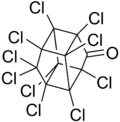Kepone
 |
|
 |
|
| Names | |
|---|---|
|
IUPAC name
decachloropentacyclo[5.3.0.02.6.03.9.04.8]decan-5-one
|
|
| Other names
Chlordecone
Clordecone Merex CAS name: 1,1a,3,3a,4,5,5,5a,5b,6-decachlorooctahydro-1,3,4-metheno-2H-cyclobuta[cd]pentalen-2-one |
|
| Identifiers | |
|
3D model (JSmol)
|
|
| ChEBI | |
| ChemSpider | |
| ECHA InfoCard | 100.005.093 |
| EC Number | 205-601-3 |
| KEGG | |
|
PubChem CID
|
|
| UNII | |
|
|
|
|
| Properties | |
| C10Cl10O | |
| Molar mass | 490.633 g/mol |
| Appearance | tan to white crystalline solid |
| Odor | odorless |
| Density | 1.6 g/cm3 |
| Melting point | 349 °C (660 °F; 622 K) (decomposes) |
| 0.27 g/100 mL | |
| Solubility | soluble in acetone, ketone, acetic acid slightly soluble in benzene, hexane |
| log P | 5.41 |
| Vapor pressure | 3.10−7 kPa |
| Thermochemistry | |
|
Std molar
entropy (S |
764 J/K mol |
|
Std enthalpy of
formation (ΔfH |
-225.9 kJ/mol |
| Hazards | |
| Main hazards | carcinogen |
| Flash point | Non-flammable |
| Lethal dose or concentration (LD, LC): | |
|
LD50 (median dose)
|
95 mg/kg (rat, oral) |
| US health exposure limits (NIOSH): | |
|
PEL (Permissible)
|
none |
|
REL (Recommended)
|
Ca TWA 0.001 mg/m3 |
|
IDLH (Immediate danger)
|
N.D. |
|
Except where otherwise noted, data are given for materials in their standard state (at 25 °C [77 °F], 100 kPa).
|
|
|
|
|
| Infobox references | |
Kepone, also known as chlordecone, is an organochlorine compound and a colourless solid. This compound is a controversial insecticide related to Mirex and DDT. Its use was so disastrous that it is now prohibited in the western world, but only after many millions of kilograms had been produced. Kepone is a known persistent organic pollutants (POP), classified among the "dirty dozen" and banned globally by the as of 2011.
The LC50 (LC = lethal concentration) is 35 μg/ L for Etroplus maculatus, 0.022–0.095 mg/kg for blue gill and trout. Kepone bioaccumulates in animals by factors up to a million-fold. Workers with repeated exposure suffer severe convulsions resulting from degradation of the synaptic junctions.
Kepone has been found to act as an agonist of the GPER (GPR30).
In the US, kepone was produced by Allied Signal Company and LifeSciences Product Company in Hopewell, Virginia. The improper handling and dumping of the substance into the nearby James River (U.S.) in the 1960s and 1970s drew national attention to its toxic effects on humans and wildlife. The product is similar to DDT and is a degradation product of Mirex. The history of Kepone incidents are reviewed in Who's Poisoning America?: Corporate Polluters and Their Victims in the Chemical Age (1982). In 2009, Kepone was included in the , which bans its production and use worldwide.
Due to the pollution risks, many businesses and restaurants along the river suffered economic losses. In 1975 Governor Mills Godwin Jr. shut down the James River to fishing for 100 miles, from Richmond to the Chesapeake Bay. This ban remained in effect for 13 years, until efforts to clean up the river began to get results.
...
Wikipedia
